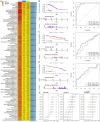Integrating cellular experiments, single-cell sequencing, and machine learning to identify endoplasmic reticulum stress biomarkers in idiopathic pulmonary fibrosis
- PMID: 39340293
- PMCID: PMC11441044
- DOI: 10.1080/07853890.2024.2409352
Integrating cellular experiments, single-cell sequencing, and machine learning to identify endoplasmic reticulum stress biomarkers in idiopathic pulmonary fibrosis
Abstract
Background: Idiopathic Pulmonary Fibrosis (IPF) presents a severe respiratory challenge with a poor prognosis due to the lack of reliable biomarkers. Recent evidence suggests that Endoplasmic Reticulum Stress (ERS) may be associated with IPF pathogenesis. This study focuses on uncovering ERS-associated biomarkers for IPF.
Methods: Sequencing data from diverse datasets were analyzed, utilizing differential gene expression analysis and Weighted Gene Co-expression Network Analysis (WGCNA). Endoplasmic Reticulum Stress (ERS)-related genes were extracted from the GeneCards database. Hub genes were identified through Protein-Protein Interaction (PPI) analysis. Diagnostic and prognostic models were developed using machine learning algorithms and validated across both training and validation sets. Additionally, techniques such as Cell-type Identification by Estimating Relative Subsets of RNA Transcripts and single-cell RNA sequencing were employed to identify potential IPF-related cells. These findings were further investigated to elucidate their underlying mechanisms through in vitro experiments.
Results: Differentially expressed genes, WGCNA-identified blue module genes, and ERS-related genes extracted from the GeneCards database were intersected, and the resulting genes were used to construct diagnostic and prognostic models. Validation using multiple datasets indicated that both the diagnostic and prognostic models possess strong predictive capabilities. PPI analysis highlighted SPP1 as a potential hub gene in IPF. Moreover, M2 macrophages were found in higher quantities in the lung tissue of IPF patients, with a significant increase in SPP1-expressing M2 macrophages compared to the control group. In vitro experiments demonstrated that exogenous SPP1 inhibited the proliferation and migration of M2 macrophages and promoted apoptosis within a certain concentration range.
Conclusion: This study identifies ERS-related biomarkers in IPF, highlighting SPP1 and M2 macrophages. The resulting diagnostic and prognostic models offer strong predictive capabilities, unveiling new therapeutic avenues.
Keywords: Endoplasmic Reticulum Stress; Idiopathic pulmonary fibrosis; M2 macrophage; SPP1; machine-learning.
Conflict of interest statement
No potential conflict of interest was reported by the author(s).
Figures







References
MeSH terms
Substances
LinkOut - more resources
Full Text Sources
Other Literature Sources
Research Materials
Miscellaneous
